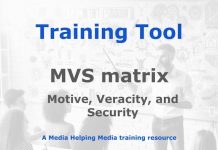
Discipline, order and a well thought out plan are essential for successful investigative journalism.
It starts with the compilation of a solid dossier, built with meticulous precision and executed with an attention to detail that ensures all key facts are thoroughly tested.
Note: The original article written by Don Ray was in American English. The text below has been edited into English English to match the MHM house-style. Many of the examples Don mentions in his list are American records, please adjust for your own country/region if using this content for training material.
The investigative journalism dossier checklist
Compiling a good dossier is like constructing a good building – you need well thought out plans, the right tools and supplies, and a strong foundation.
All your work must be solidly build with precision. And when you’re done it must be leak-proof.
Consider these 10 simple steps for preparing a thorough piece of investigative journalism:
- Identify the person
- Ensure that you have the correct spelling of the first, middle and last name.
- Find a date of birth, or at least an age.
- Use online credit-header services, maintain indices of voter records, drivers’ licenses, employment checks, friends, lovers, relatives…
- … or just ask him or her.
- Locate the person
- Once you nail down the most permanent domicile for the person, you’ll be laying the foundation for later steps.
- Use telephone directories, city directories, voter records, property records, online credit-header services, interview friends, former neighbours.
- Visit the morgue.
- See what’s already been written
- There is no point in reinventing the wheel.
- Check your own story archives first.
- Search online for articles about the person.
- Then hit every local newspaper site, any Who’s Who that match his or her profession, region or specialty.
- Check local public records
- Whether or not the person is from your local area, do a thorough search at your town or city hall, county clerk’s office and local branches of state and federal offices.
- Look specifically for business permits, animal licences, building permits, recorded deeds, trust deeds, conveyances, notices of sale, powers of attorney, liens, local, state and federal tax, bonds, agreements and other documents, property tax records, unsecured property tax records, local vehicle tax records, renters’ tax records, fictitious business (assumed name) filings, birth, marriage and death certificates, consumer affairs licenses, UCC filings, state driving records.
- Search the courts for lawsuits
- Use the online services to search the party indices, but eventually you must try to look at the actual case files at the courthouse.
- Don’t miss any level of court – small claims, justice, municipal, metropolitan, district, superior, divorce, state, appeals, U.S. District Court, U.S. Tax Court, naturalisation court and most importantly, U.S. Bankruptcy Court.
- Check for criminal activity
- Depending upon your own state’s open records laws, you might be able to check with local police and sheriffs, state police, courts, from justice court all the way up to U.S. District Court.
- Then check with local, county, state and federal jails and prisons – including the probation department and the parole department.
- This is a good time to plug in any aliases.
- Look for employment information
- Make direct calls to his or her current and past employers.
- Many times they won’t ask who you are if you simply ask for the personnel department and then matter-of-factly say, “employment verification please.”
- If they ask who you are, of course tell the truth.
- Try to get a copy of the company, corporate or government phone directory for his or her work establishment.
- Ask current or former employers for a copy of his or her resume.
- Ask your subject for it.
- Check state corporation and federal SEC records for involvement in corporations.
- Look for the legal owner of his or her car.
- Is it his employer’s credit union? The Postal Credit Union, etc.?
- Verify professional licences, credentials, degrees and awards
- If the person is a physician, dentist or any other type of licensed healthcare worker, you must verify the licence.
- If you’ve asked him or her for their resume, check out every claim.
- If there’s a Who’s Who listing for the person, check out every claim. Many such directories don’t check.
- Check high schools and universities for graduation verification. Get copies of theses and dissertations from the Library of Congress.
- Check out any claims of military service, actual combat, injuries and awards for valour.
- Check campaign contributions, filings and conflict of interests
- Not just for the current office they are holding or the most recent election.
- Check them out as far back as you can.
- See if they or any other potential interviewees contributed to others’ campaigns.
- Look for family members, friends, victims and enemies
- Talk to people who would know him or her.
- Don’t overlook current or former neighbours, ex-spouses, former lovers, business associates, school mates, teachers, supervisors, even babysitters.
By Don Ray

Questions
- What is the primary purpose of compiling a dossier in investigative journalism?
- List three key elements necessary for constructing a solid dossier.
- Describe the importance of verifying the correct spelling of a person’s name in investigative journalism.
- Explain why it is crucial to check local public records during an investigation.
- How can online services assist in searching for lawsuits related to a person?
- Discuss the role of employment verification in the investigative process.
- Why is it important to verify professional licences and credentials?
- Analyse the significance of checking campaign contributions and potential conflicts of interest.
- How can interviewing family members, friends, and associates contribute to the investigation?
- Set out the steps outlined in the text to create a comprehensive plan for conducting an investigative journalism project.
Answers
- The primary purpose is to ensure all key facts are thoroughly tested and to provide a strong foundation for the investigation.
- Well thought out plans, the right tools and supplies, and a strong foundation.
- It ensures accuracy and helps in locating the correct individual, which is crucial for gathering reliable information.
- Local public records can provide essential information such as business permits, property records, and legal documents that are vital for the investigation.
- Online services can help locate party indices and provide access to case files, which are essential for understanding legal proceedings involving the person.
- Employment verification helps confirm the person’s work history and can reveal connections to organisations or other individuals.
- Verifying licenses and credentials ensures the person’s claims are accurate and can uncover any discrepancies or fraudulent activities.
- Checking campaign contributions and conflicts of interest can reveal biases, influences, or unethical behaviour that may impact the investigation.
- Interviewing these individuals can provide personal insights, corroborate information, and uncover new leads or perspectives.
- The steps involve identifying and locating the person, reviewing existing information, checking public records, verifying credentials, and interviewing relevant individuals to gather comprehensive and accurate data.

The foundation
While discipline and order are crucial, the true essence of a powerful investigative dossier lies in critical thinking and contextual awareness. It’s not just about collecting facts, but understanding their significance and interrelationships.
- Strategic questioning: Before diving into data collection, define the central questions your investigation seeks to answer. What narrative are you trying to uncover? This guides your research and prevents information overload.
- Ethical considerations: Investigative journalism is a powerful tool with the potential to impact lives. A strong dossier includes a conscious awareness of ethical implications. Consider the potential harm versus the public interest.
- Anticipating counterarguments: A “leak-proof” dossier anticipates potential challenges to your findings. Consider how your subject or their allies might respond, and gather evidence to preemptively address those counterarguments.
Expanding the checklist
The original checklist provides a solid base, but here’s how to enhance each step:
-
Identifying the person
- Digital footprint analysis: Explore social media, online forums, and public comments to understand the subject’s online persona, beliefs, and interactions.
- Network mapping: Use tools to visualise the subject’s connections, revealing potential relationships and influences.
- Psychological profiling: When appropriate, consider the subject’s behavioural patterns and potential motivations, drawing on expert analysis if needed.
-
Locating the person
- Geolocation data: Explore publicly available geolocation data (with ethical considerations) to track movements and potential locations.
- Domain name registration: If the subject owns websites, examine domain registration records for contact information and potential connections.
- Social media geotags: Review any geotags attached to social media posts.
-
See what’s already been written
- Sentiment analysis: Use tools to analyse the tone and sentiment of existing articles, revealing public perception and potential biases.
- Citation analysis: Track citations to identify key sources and potential areas of influence.
- Deep web searches: Explore databases and forums not indexed by standard search engines.
-
Check local public records
- Environmental records: Explore environmental records for potential violations or connections to controversial projects.
- Freedom of information act (FOIA) requests: Utilise FOIA requests to access government documents not readily available to the public.
- Data visualisation: Organise public records data into visualisations to reveal patterns and anomalies.
-
Search the courts for lawsuits
- Docket analysis: Analyse court dockets to identify trends in litigation and potential patterns of behaviour.
- Expert witness testimony: Examine expert witness testimony to understand the subject’s involvement in legal proceedings.
- Foreign court records: If applicable, explore court records in other countries.
-
Check for criminal activity
- Open-source intelligence (OSINT): Utilise OSINT techniques to explore online forums and dark web marketplaces for potential connections to criminal activity.
- Forensic accounting: If financial irregularities are suspected, consult with forensic accountants to trace money trails.
- Cybersecurity analysis: Investigate potential cybercrimes, such as hacking or data breaches.
-
Look for employment information
- LinkedIn analysis: Examine LinkedIn profiles for detailed employment history, endorsements, and connections.
- Professional associations: Explore membership records of professional associations for potential ethical violations or conflicts of interest.
- Financial disclosures: If applicable, examine financial disclosures for potential conflicts of interest.
-
Verify professional licences, credentials, degrees, and awards
- Academic database searches: Utilise academic databases to verify degrees and publications.
- Professional certification verification: Contact professional certification boards to verify credentials.
- Fact-checking tools: Employ fact-checking tools to verify claims and identify potential misinformation.
-
Check campaign contributions, filings, and conflicts of interests
- Political donation databases: Utilise political donation databases to track campaign contributions and potential influence.
- Lobbying records: Explore lobbying records to identify potential conflicts of interest.
- Offshore accounts: If applicable, investigate potential offshore accounts and financial dealings.
-
Look for family members, friends, victims, and enemies
- Social network analysis: Utilise social network analysis tools to map the subject’s relationships and identify key influencers.
- Trauma-informed interviewing: When interviewing victims or vulnerable individuals, employ trauma-informed interviewing techniques.
- Protecting sources: Prioritise the safety and anonymity of sources, particularly those who may be at risk.
The importance of context and narrative
Ultimately, a strong dossier is not just a collection of facts, but a coherent narrative. It’s about connecting the dots, revealing patterns, and providing context.
- Timeline construction: Create a detailed timeline of events to establish a clear chronological order.
- Data triangulation: Cross-reference information from multiple sources to verify accuracy and identify potential discrepancies.
- Narrative arc: Craft a compelling narrative that engages the audience and conveys the significance of your findings.
By combining meticulous research with critical thinking and ethical awareness, investigative journalists can build powerful dossiers that hold the powerful accountable and inform the public.
Lesson plan for trainers
If you are a trainer of journalists we have a free lesson plan: ‘Investigative dossier‘ which you are welcome to download and adapt for your own purposes.









